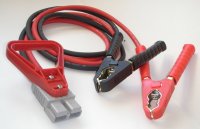Amarillo
Tom
Super Poster
VIP Member
I have just made a 5 metre extension lead so that our fridge can be powered in the driveaway awning.
It got me wondering... If I managed to flatten the engine battery, could I safely get the engine restarted using the leisure battery with the leads and connectors I have.
The extension lead is Anderson to Anderson with 6mm2 cable.
I have a ring terminal to Anderson lead with a 50 amp fuse, connected directly to the leisure battery.
In daylight, the leisure battery is being continuously charged from solar panels with up to 15 amps.
Being totally non technical, what I think might work is:
1. Remove one Anderson connector from the long extension lead.
2. Tape the positive lead contact to the positive battery terminal.
3. Tape the negative lead contact to the engine block.
4. Plug the extension lead Anderson connector into the leisure battery's Anderson connector.
5. Leave in sunshine all day.
6. Disconnect all leads and try to start the vehicle.
What I am unsure about:
1. Is 6mm2 cable sufficient to recharge a flat battery from a fully charged battery of the same type?
2. Is a 50 amp fuse OK?
3. If recharging a flat battery from a charged battery, without drawing current, would it be better to connect the two negative battery terminals?
Have I missed anything else? Would there be a better way to do things?
It got me wondering... If I managed to flatten the engine battery, could I safely get the engine restarted using the leisure battery with the leads and connectors I have.
The extension lead is Anderson to Anderson with 6mm2 cable.
I have a ring terminal to Anderson lead with a 50 amp fuse, connected directly to the leisure battery.
In daylight, the leisure battery is being continuously charged from solar panels with up to 15 amps.
Being totally non technical, what I think might work is:
1. Remove one Anderson connector from the long extension lead.
2. Tape the positive lead contact to the positive battery terminal.
3. Tape the negative lead contact to the engine block.
4. Plug the extension lead Anderson connector into the leisure battery's Anderson connector.
5. Leave in sunshine all day.
6. Disconnect all leads and try to start the vehicle.
What I am unsure about:
1. Is 6mm2 cable sufficient to recharge a flat battery from a fully charged battery of the same type?
2. Is a 50 amp fuse OK?
3. If recharging a flat battery from a charged battery, without drawing current, would it be better to connect the two negative battery terminals?
Have I missed anything else? Would there be a better way to do things?


 ️
️
 ️
️








